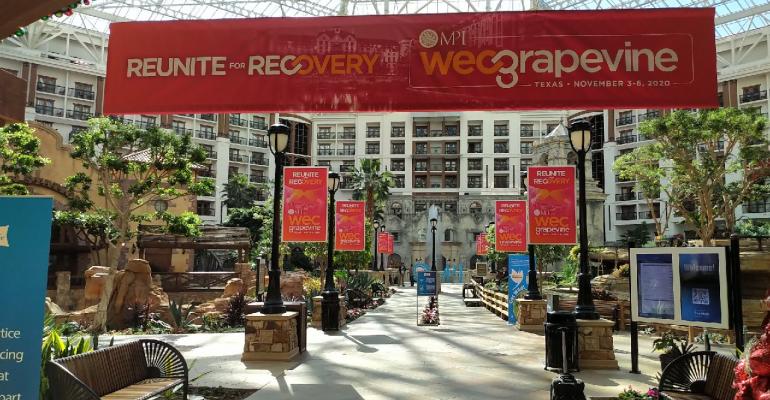I want to be a leader in planning meetings safely. To get there, I decided to attend Meeting Professionals International’s World Education Congress in person in Grapevine, Texas, November 3-6. I needed to experience what my attendees would experience, in the air and on the ground, and learn from the best practices that MPI put in place so I can make meetings safer right from the start. What’s changing for meetings in the Covid era? Here are some notes from the journey.
Pre-board at Minneapolis−Saint Paul International Airport
Check in is fast, with few people at the airport. With TSA pre-check, security takes less than 10 minutes. Longest line is at Caribou Coffee. It is very quiet in the terminal.
My plane can hold 78 people, but Delta has limited it to 51 seats, and on this flight, there are only 31 passengers. Everyone is wearing a mask. Only one person besides myself is wearing a face shield.
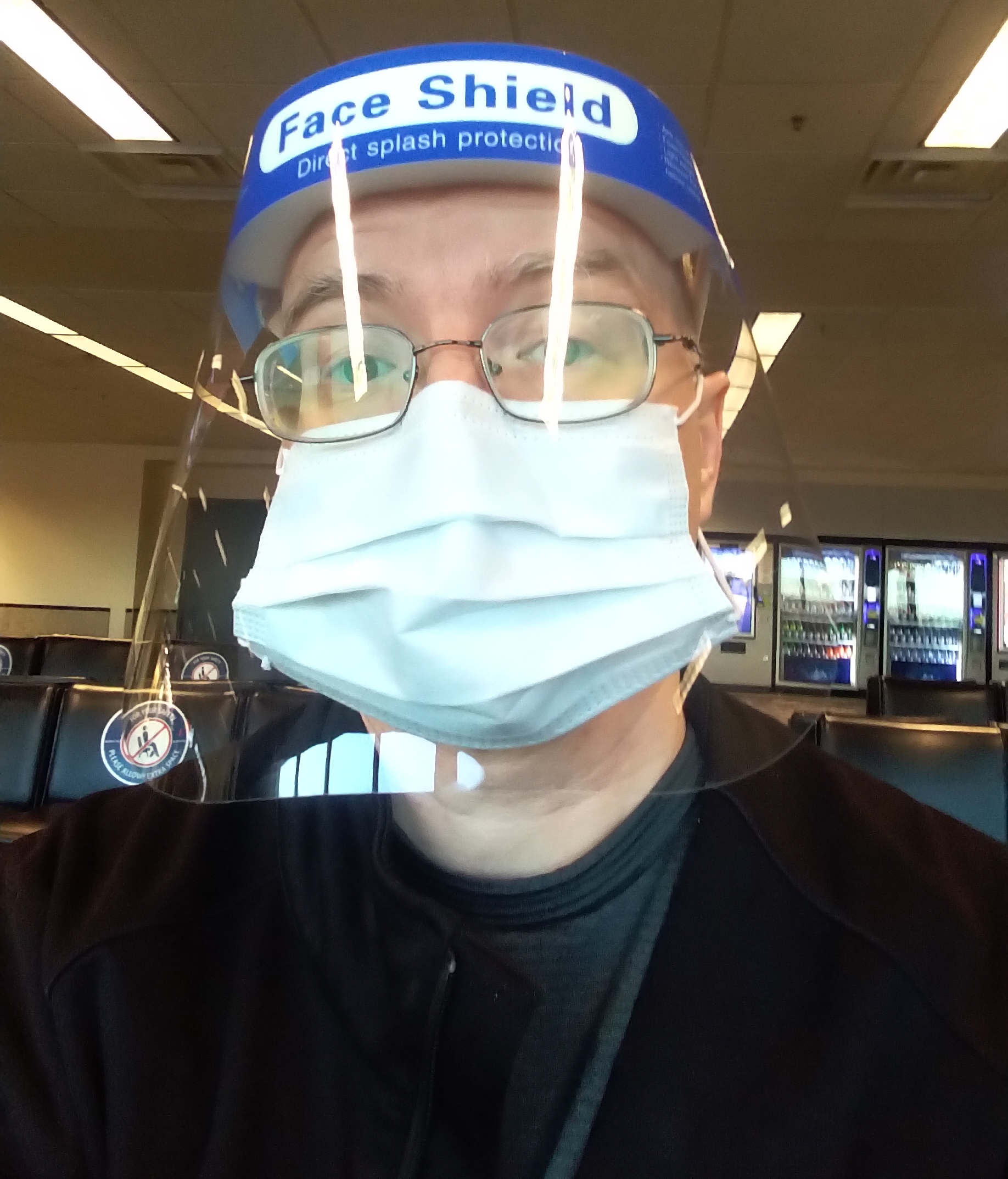 Flight to Dallas-Fort Worth
Flight to Dallas-Fort Worth
The middle seat in my row is blocked unless you’re traveling with someone. I take a window seat to be further from traffic in the aisle. They offer beer and wine in first class along with a snack bag that included a small bottle of water.
In the pre-flight announcement, flight attendants don’t demonstrate how to put on the face mask in the case of loss of cabin pressure. They refer us to the safety card in the seat pocket. It’s not hard to find because the only other thing there is the air sickness bag. No magazines. Also, they ask us to use the air-sickness bag for items you need to dispose of during the flight. They pass out a cleaning wipe once seated, and there is a tiny single cleaning wipe in the snack bag.
Ground Transfer
I take a car service from the airport to the event hotel, the Gaylord Texan Resort & Convention Center. I normally use Lyft, Uber, or shuttle buses, but I figured a car service would be direct and allow for contact tracing if needed. The driver wears a mask and sanitizes his hands after loading the luggage, before getting into the car, and then before taking the bags to the bellhops. There isn’t a shield between me and the driver, but air is flowing through.
Hotel Check In
Check in is relatively normal other than the plexiglass shield, which makes it hard to hear the person checking me in. The plexiglass isn’t very wide—about the same as the shield at the bell stand (which isn’t effective because there was collateral in front of it).
In the hotel room, there are no magazines or other collateral, but they do have a pack of antiseptic wipes and hand sanitizer for me, as well as a welcome letter. 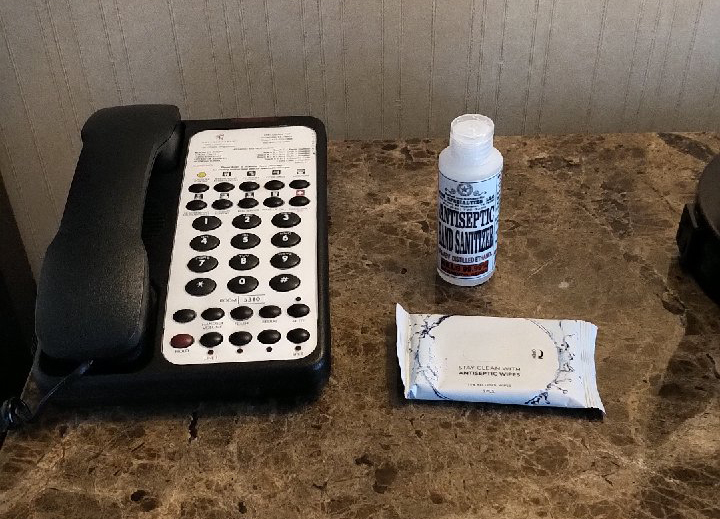
An attendee bag is delivered in a safe and unique manner: The hotel has an eight-foot-by-three-foot box in front of the doors for the Celebrity Services area. The box is solid on the sides, and in the front, curtains frame a center square with a doorbell. There is a person there who welcomes me and presses the doorbell. Then, from behind the curtains a gloved hand reaches out with a bag for me, containing a bottle of mineral water, a bottle opener (no branding), and a cookie in the shape of Texas.
First-Night Networking
Before heading to the opening celebration on Main Street in Grapevine, I have a drink at the hotel’s Silver Bar. I don't see a lot of mask wearing or social distancing over the 45 minutes I am here, so that’s a concern. I do see one group not drinking that’s keeping all masks on. 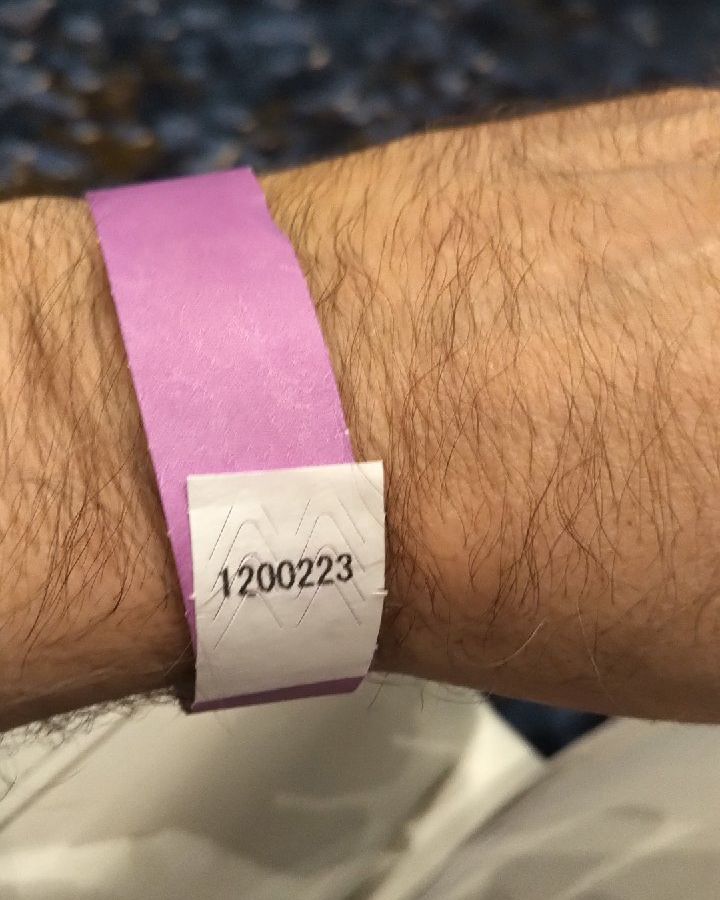
Before getting on the bus, I fill out a health questionnaire, which gives a green thumbs up if you are good to go or a red thumbs down if you need to visit the on-site physicians. Then I get a temperature check followed by a wristband that indicates I passed.
Passengers on the buses fill in every other seat. Some buses have seats taped off if it is an offset arrangement. At the venue, there is a temperature-check station for locals. The event is outside, but masks are required. I only see a few people flaunting that rule—99.5 percent are wearing masks (just taking them off briefly to drink or eat).
All food stations at the event have QR-code menus plus shields between servers and attendees. Two concerns: It is hard to hear people, which makes social distancing difficult, and it is an open-bar event, where alcohol could possibly affect attendees’ judgement about social distancing. But I learn that throughout the WEC, open bars are of shorter duration than in other years.
Day Two
The first full day of the WEC begins with the same health screening and temperature check, and a new wristband. We are scanned in via iPad and the QR code on our badges when we enter each section of the convention center.
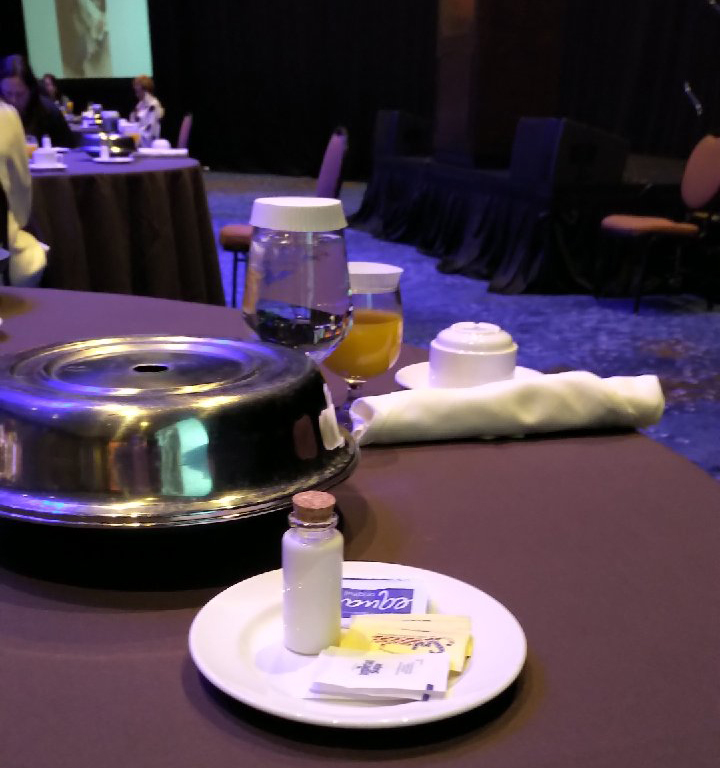 At breakfast, tables are set with fruit and water. Orange juice, coffee, and a hot breakfast are delivered by the waiter, but each person has his or her own set of cream and sweeteners for the coffee. A maximum of four people sit at each table.
At breakfast, tables are set with fruit and water. Orange juice, coffee, and a hot breakfast are delivered by the waiter, but each person has his or her own set of cream and sweeteners for the coffee. A maximum of four people sit at each table.
Many people don’t put their masks back on after eating, even when we have table activities for the session. 
Meet-Up
My first session is a meet-up for freelancers, independent planners, and small-business owners. There are six tables with four chairs at each. We use a cool collaboration technology called WeFrame (pictured right) and have a productive discussion about how MPI can support small business members, the devastation of the pandemic, and the costs of going hybrid.
A couple of attendees take off their masks to talk; one moves six feet away; but one does not. People like my WinBridge personal amplifier, which makes it easier to talk together while at a distance.
Quote of the session: If one of the presidential candidates had supported a hospitality-industry bailout, they would have won by a landslide.
General Sessions
Attendees enter and exit the ballroom through different doors. Wristbands are checked as you enter. Attendees are spread out and there are no seats right in front of the stage.
Lots to chew on in the first general session, which features a socially distanced panel of industry leaders. One important takeaway: An individual code of conduct is important in the recovery of our industry. As one speaker says: “We in this room need to call each other out on not following the conduct policy.” MPI’s president and CEO Paul VanDeventer does a good job in explaining what we are doing here: Taking risks in content and innovation but not with safety.
All speakers wear a microphone. There are no audience mics. In some sessions, there is a technology solution for Q&A, but not all. In one breakout, the moderator asks attendees to remove their mask to ask questions. This was concerning; it makes me wonder why ever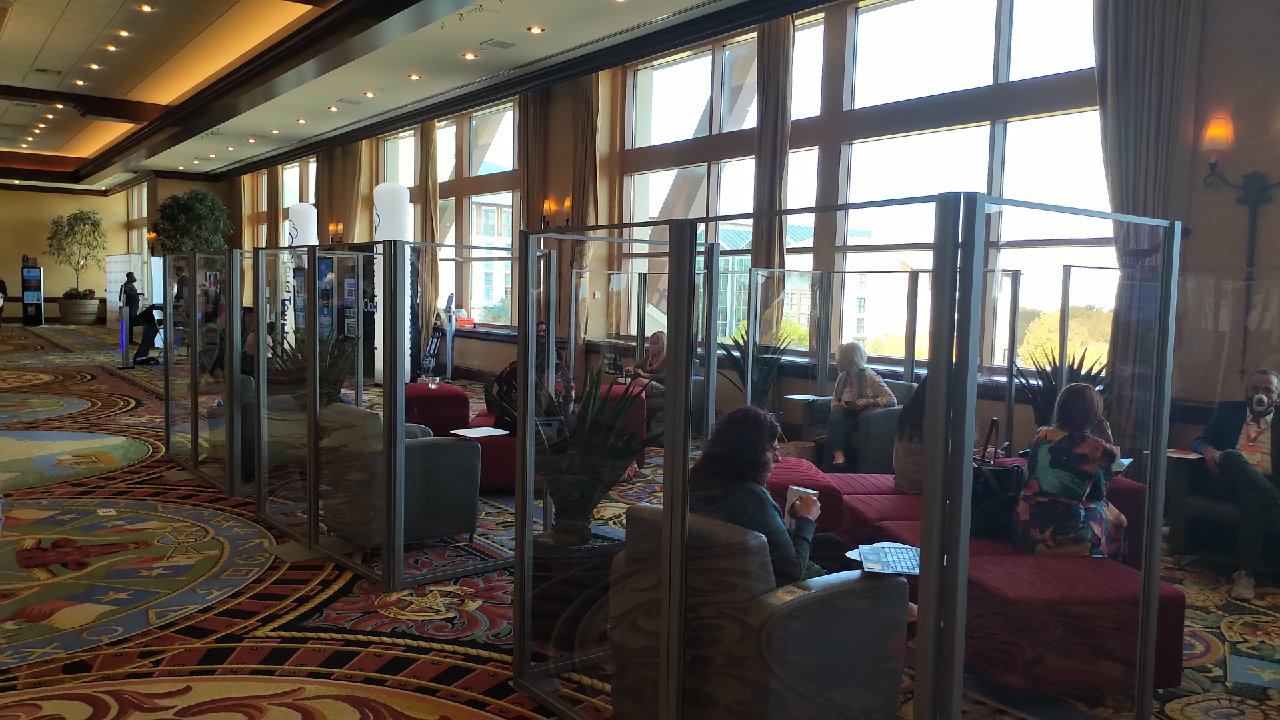 y session doesn’t have a Q&A technology.
y session doesn’t have a Q&A technology.
I appreciate the tub of sanitizing wipes at the water stations in the back of the ballroom, but I can’t get a wipe out of either without removing the cover. Providing a monitor would have been helpful. Hand-sanitizing stations are available throughout the rest of the facility.
There were very few places to sit besides meeting rooms, but outside one ballroom is some plexiglass-partitioned seating that seems to provide separation but also some community.
Lunches
Attendees are excused from the general session for lunch by section, based on a color card at their chair, and are led down to a ballroom for lunch. Each section is taken to a different door, and there are multiple buffet stations for each section. Attendees are seated four to a table max, and organizers wanted minimal mingling. However, they have a band playing, making it hard to hear. Beverages are grab and go. Unfortunately, the unsweet and sweet tea are in the same tub and it’s hard to see which was which, so there is a lot of bottle-touching. Having someone pass out drinks would feel safer to me.
On the flip side, the fork-chopstick combo at the lunch is the best new utensil I didn't know I needed, but I now do!
The way they’re doing coffee stations has changed a bit, adding adapters to the urns so they pour when a cup is underneath rather than needing the attendee to press a lever. The water station is similar. They use single-serve cups, cardboard sleeves, and individual coffee-condiment kits. 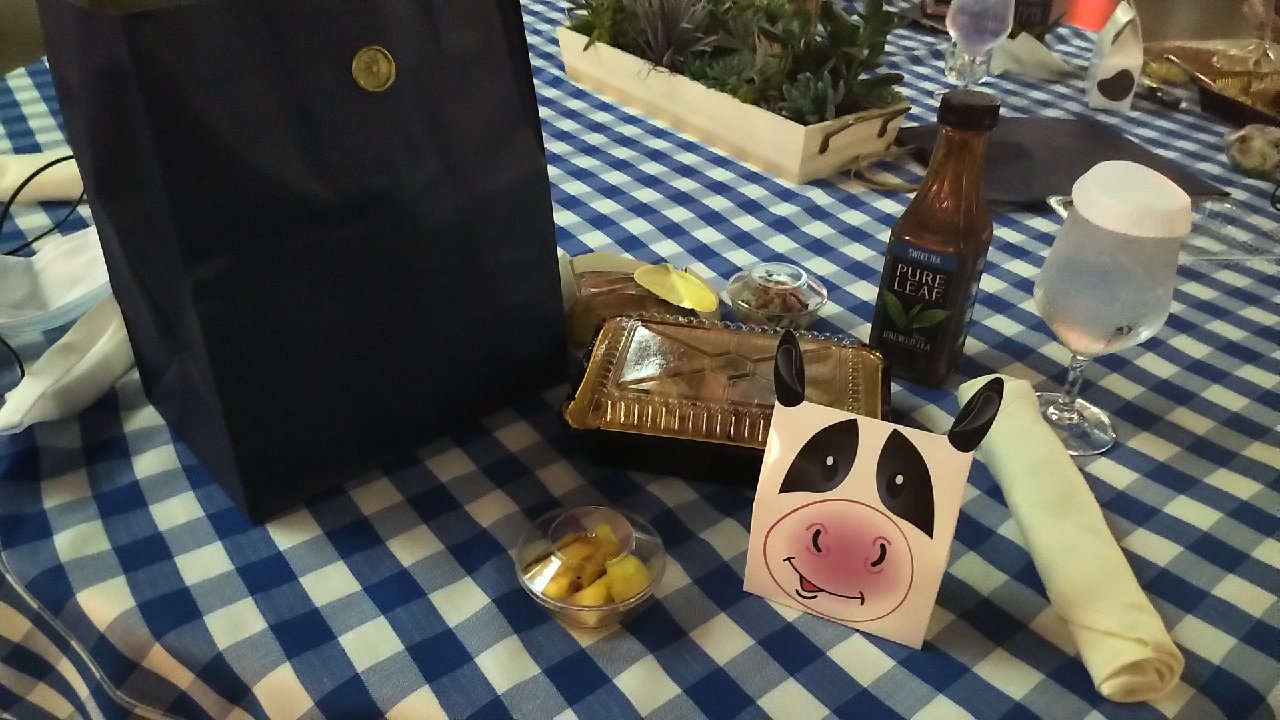
The next day’s lunch is grab and go, with a separate station for special meals. A picture of what is in the bag was on display.
Mask Compliance
In some sessions MPI has people checking mask wearing, but not always. They have a fun way of doing it: Walking through with a sign saying "Mask Up Y'all" in Texas colors.
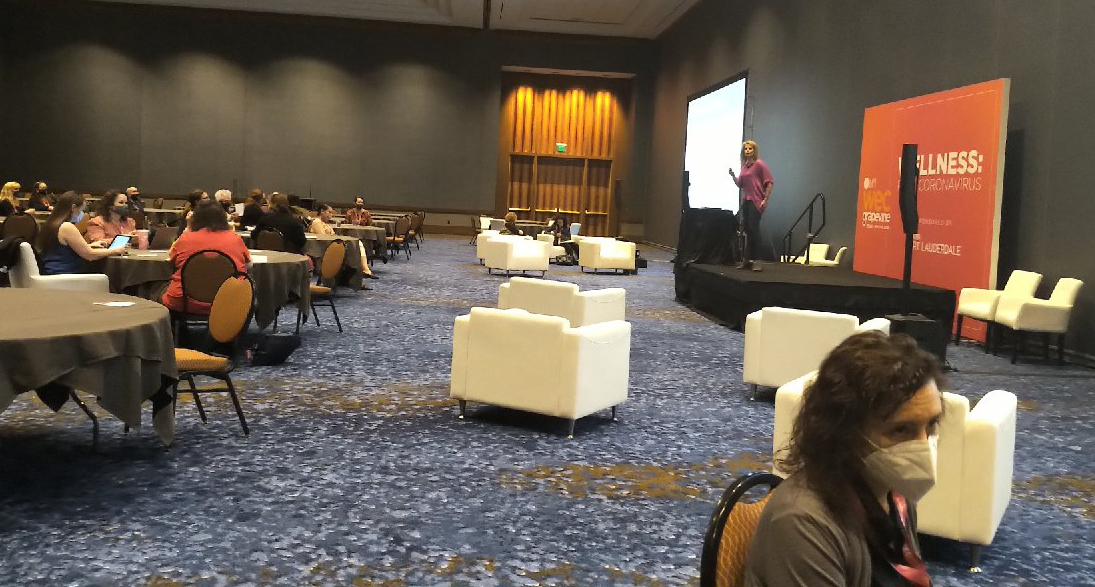 MPI is using the same security company it’s had for more than 20 years, Professional Executive Emergency Resources (PEER). They’re here to do all the normal things, like making sure the facilities are safe, responding to medical crises, and ensuring no outside people enter the event, plus now also checking masks and social distancing. PEER has four staff onsite. They have had to deal with a couple of people on mask issues, however almost all people have been cooperating.
MPI is using the same security company it’s had for more than 20 years, Professional Executive Emergency Resources (PEER). They’re here to do all the normal things, like making sure the facilities are safe, responding to medical crises, and ensuring no outside people enter the event, plus now also checking masks and social distancing. PEER has four staff onsite. They have had to deal with a couple of people on mask issues, however almost all people have been cooperating.
The MPI WEC experience answers lots of questions for me, but raises other issues that I will be working through:
• Before the meeting happens, there needs to be a discussion about who is responsible for enforcing protocols on site.
• What is a good ratio of safety monitors to attendees?
• Speakers should be prepped on how to ask attendees to mask up.
• It would be helpful to communicate to attendees a standard for mask wearing. For example, during sessions, should attendees remove their masks to ask questions? At receptions and meals, how long should a mask be off when drinking or eating? Should attendees remove the mask then pull it back up right away, or is it okay to leave it down for a few minutes?
Rendezvous
MPI’s Rendezvous party is held at the Glass Cactus, a lakefront nightclub a short bus ride from the hotel. At the door they check for the wristbands we were issued that morning. Is one temperature check a day okay for a schedule that goes over a long time period? I don't have an answer, but it made me think.
Mask enforcement is higher at Rendezvous than at some other events this week—thank you to the DJ for constant reminders. They have plastic dividers on the tables, for the bartenders, and at the food stations. They also have floor stickers asking people to social distance even on the dance floor. There is good outside space—decks on both levels.
Final Day
Wearing an N95 mask and my face shield today seems like a good idea. The median time for people to show symptoms is five days, and they can spread Covid up to two days before symptoms appear. That means if someone was infected on Tuesday, they would be able to spread today. I'm taking no chances.
The closing celebration has wonderful entertainment—aerialists and a 12-person band—but a few safety concerns: no paper towels in the bathrooms, only air hand dryer—a big no-no for Covid. There are hand sanitizers at the food stations, at the entry, and outside the bathrooms, but none at the bars; food stations are staffed but food was out in open; and the bus for the 25-minute ride back to the hotel is relatively crowded; two people in the seats in front of me and two in the seats behind me, with some people taking seats marked off with caution tape.
Reflections
With Covid, your event is only as safe as its weakest link. There might be attendees who ignore the code of conduct, or a contractor or volunteer who doesn't follow the safety plan.
Things to consider:
- If you hold events in a variety of destinations with different Covid standards, will you change your protocols from city to city?
- Communication is more important than ever. Everyone needs to be on the same page.
- Consider limiting or removing functions with alcohol.
- Use a third-party “go” or “no-go” standard to decide if an event will happen. Think about whether that standard should look at the Covid rates where attendees are coming from as well as in the destination.
- Ask yourself: Can everyone involved with the event follow protocols at all times?
While I acknowledge I’m someone who really wants to play it safe, I’m just not sure we’re ready for large in-person meetings. In the past two weeks, I’ve worked an in-person event and attended WEC, and I don't know if we can trust attendees to follow safety protocols. MPI did a thorough job of making the WEC a safe event, but human nature is a wild card. At this point, events could be playing a dangerous game while the virus is at record levels in many parts of the country.
Jim Louis, MS, CMP, CAE, DES, is president of Best Meetings Inc. and founder and weekend moderator for the Meetings Community (MeCo).

